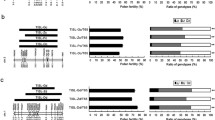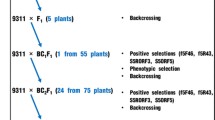Abstract
The incomplete fertility of japonica × indica rice hybrids has inhibited breeders’ access to the substantial heterotic potential of these hybrids. As hybrid sterility is caused by an allelic interaction at a small number of loci, it is possible to overcome it by simple introgression at the major sterility loci. Here we report the use of marker-assisted backcrossing to transfer into the elite japonica cv. Zhendao88 a photoperiod-sensitive male sterility gene from cv. Lunhui422S (indica) and the yellow leaf gene from line Yellow249 (indica). The microsatellite markers RM276, RM455, RM141 and RM185 were used to tag the fertility genes S5, S8, S7 and S9, respectively. Line 509S is a true-breeding photoperiod-sensitive male sterile plant, which morphologically closely resembles the japonica type. Genotypic analysis showed that the genome of line 509S comprises about 92% japonica DNA. Nevertheless, hybrids between line 509S and japonica varieties suffer from a level of hybrid sterility, although the line is highly cross-compatible with indica types, with the resulting hybrids expressing a significant degree of heterosis. Together, these results suggest that segment substitution on fertility loci based on known information and marker-assisted selection are an effective approach for utilizing the heterosis of rice inter-subspecies.






Similar content being viewed by others
Abbreviations
- CMS:
-
Cytoplasmic male sterility
- MAS:
-
Marker-assisted selection
- PSMS/TSMS:
-
Photo/temperature-sensitive male sterile
- WCG:
-
Wide compatibility gene
- WCV:
-
Wide-compatibility variety
- YGL:
-
Yellow green leaf
References
Araki H, Toya K, Ikehashi H (1988) Role of wide compatibility genes in hybrid rice breeding. In: RI IR (ed) Hybrid rice, 79–83. IRRI, Manila
Bai DL, Luo XH (1995) The combination and exploitation of new two-line rice hybrid, LiangyouPeite. Huan Agric Sci 6:6–8
Chen L (ed) (2001) The principles and techniques of two-line hybrid rice. Shanghai Scientific and Technical Publications, Shanghai
Chen X, Temnykh S, Xu Y, Cho YG, McCouch SR (1997) Development of a microsatellite framework map providing genome-wide coverage in rice (Oryza sativa L.). Theor Appl Genet 95:553–567
Dellaporta SL, Wood J, Hicks JB (1983) A plant DNA mini preparation: version II. Plant Mol Biol Rep 1:19–21
Gao FY, Lu XJ, Wang WM, Sun SS, Li ZH, Li HJ, Ren GJ (2009) Trait-specific improvement of a cytoplasmic male-sterile line using molecular marker-assisted selection in rice. Crop Sci 49:99–106
Hanada H, Hirai M (2003) Development of a genetic marker linked to the tendril trait of Sweet Pea (Lathyrus odoratus L.). Breed Sci 53:7–13
Ikehashi H, Araki H (1986) Genetics of F1 sterility in remote crosses of rice (Oryza sativa L.). In: RI IR (ed) Rice genetics. IRRI, Manila, pp 119–130
Jing W, Zhang WW, Jiang L, Chen LM, Zhai HQ, Wan JM (2007) Two novel loci for pollen sterility in hybrids between the weedy strain Ludao and the Japonica variety Akihikari of rice (Oryza sativa L.). Theor Appl Genet 114:915–925
Johan DP, Jeroen RV (2003) Breeding by design. Trends Plant Sci 8:330–334
Khush GS (1999) Green revolution: preparing for the 21st century. Genome 42:646–655
Li RH, Cai HW, Wang XK (1995) Discovery of a specific esterase band associated with photo- and thermo-sensitive genic male sterile rice. Chin Sci Bull 40:414–416
Li DT, Chen LM JL, Zhu SS, Zhao ZG, Liu SJ, Su N, Zhai HQ, Ikehashi H, Wan JM (2007a) Fine mapping of S32(t), a new gene causing hybrid embryo sac sterility in a Chinese landrace rice (Oryza sativa L.). Theor Appl Genet 114:515–524
Li SQ, Yang DC, Zhu YG (2007b) Characterization and use of male sterility in hybrid rice breeding. J Integr Plant Biol 49:791–804
Lu XG, Gu MH, Li CQ (eds) (2001) Theory and technology of two-line hybrid rice. China Science Press, Beijing
Lu XG, Mou TM, Hoan NT, Virmani SS (2002) Two-line hybrid rice breeding in and outside of China. In: Abstract of the fourth international symposium hybrid rice, 14–17 May 2002, Hanoi, Vietnam, p 6
Mou T, Li C, Yang G, Lu X (1995) Genetical studies on seedling leaf color in purple rice. Chin J Rice Sci 9:45–48
Negrao S, Oliveira MM, Jena KK, Mackill D (2008) Integration of genomic tools to assist breeding in the japonica subspecies of rice. Mol Breed 22:159–168
Nei M (1987) Molecular evolutionary genetics. Columbia University Press, New York, pp 106–107
Oka H (1988) Origin of cultivated rice. In: Elsevier (ed) Scientific Societies Press, Tokyo, pp 181–250
Qiu SQ, Liu KD, Jiang JX, Song X, Xu CG, Li XH, Zhang QF (2005) Delimitation of the rice wide compatibility gene S5 n to a 40-kb DNA fragment. Theor Appl Genet 111:1080–1086
Rohlf EJ (1992) Numerical taxonomy and multivariate analysis system, NTSYS-pc program. Applied Biostatistics Inc., 3 Heritage lane, Setauket, NY 11733
Singh SP, Sundaram RM, Biradar SK, Ahmed MI, Viraktamath BC, Siddiq EA (2006) Identification of simple sequence repeat markers for utilizing wide-compatibility genes in inter-subspecifc hybrids in rice (Oryza sativa L.). Theor Appl Genet 113:509–517
Song X, Qiu SQ, Xu CG, Li XH, Zhang QF (2005) Genetic dissection of embryo sac fertility, pollen fertility, and their contributions to spikelet fertility of intersubspecific hybrid in rice. Theor Appl Genet 110:205–211
Sweeney MT, Thomson MJ, Pfeil BE, McCouch S (2006) Caught red-handed: Rc encodes a basic helix-loop-helix protein conditioning red pericarp in rice. Plant Cell 18:283–294
Temnykh S, Park WD, Ayres N, Cartinour S, Hauck N, Lipovich L, Cho YG, Ishii T, McCouch SR (2000) Mapping and genome organization of microsatellite sequence in rice (Oryza sativa L.). Theor Appl Genet 100:697–712
Wan JM, Ikehashi H (1995) Identification of a new locus S-16 causing hybrid sterility in native rice varieties (Oryza sativa L.) from Tai-hu Lake region and Yunnan province, China. Breed Sci 45:161–170
Wan JM, Yanagihara S, Kato H, Ikehashi H (1993) Multiple alleles at a new locus causing hybrid sterility between a Korean indica variety and japonica variety in rice. Jpn J Breed 43:507–516
Wan JM, Yamaguchi Y, Kato H, Ikehashi H (1996) Two new loci for hybrid sterility in cultivated rice (Oryza sativa L.). Theor Appl Genet 92:183–190
Wang YH, Xue YB, Li JY (2005) Towards molecular breeding and improvement of rice in China. Trends Plant Sci 10:610–614
Wang GW, He YQ, Xu CG, Li XH, Zhang QF (2006) Fine mapping of S5-Du, a gene conferring wide-compatibility for pollen fertility in inter-subspecific hybrids of rice (Oryza sativa L.). Theor Appl Genet 112:382–387
Wu ZM, Zhang X, He B, Diao LP, Sheng SL, Wang JL, Guo XP, Su N, Wang LF, Jiang L, Wang CM, Zhai HQ, Wan JM (2007) A chlorophy11-deficient rice mutant with impaired chlorophyllide esterification in chlorophy11 biosynthesis. Plant Physiol 145:29–40
Xu YB (2003) Developing marker-assisted selection strategies for breeding hybrid rice. Plant Breed Rev 23:73–174
Xu YB, Crouch JH (2008) Marker-assisted selection in plant breeding: from publication to practice. Crop Sci 48:391–407
Yanagihara S, Kato H, Ikehashi H (1992) A new locus for multiple alleles causing hybrid sterility between an Aus variety and javanica varieties in rice (Oryza sativa L.). Jpn J Breed 42:793–801
Yuan LP (1992) The strategy of the development of hybrid rice breeding. In: Yuan LP (ed) Current status of two line hybrid rice research, 1–5. Agricultural Publishing Ltd, Beijing (in Chinese, English summary)
Zhang GQ, Lu YG, Zhang H, Yang JC, Liu GF (1994) Genetic studies of the hybrid sterility in cultivated rice (Oryza sativa L.). IV. Genotypes for F1 pollen sterility (in Chinese with English abstract). Acta Genet Sin 21:34–41
Zhang J, Xu Y, Wu X, Zhu L (2002) A bentazon and sulfonylurea sensitive mutant: breeding, genetics and potential application in seed production of hybrid rice. Theor Appl Genet 105:16–22
Zhao ZG, Jiang L, Zhang WW, Yu CY, Zhu SS, Xie K, Tian H, Liu LL, Ikehashi H, Wan JM (2007) Fine mapping of S31, a gene responsible for hybrid embryo-sac abortion in rice (Oryza sativa L.). Planta 226:1087–1096
Zhou T, Wang L, Cheng ZB, Fan YJ, Zhou YJ (2009) Mechanism and inheritance of resistance to rice stripe disease in the japonica rice cultivar zhendao 88. Sci Agric Sin 42(1):103–109 (in Chinese abstract)
Zhu SS, Jiang L, Wang CC, Zhai HQ, Li DT, Wan JM (2005) The origin of a weedy rice Ludao in China deduced by a genome wide analysis of its hybrid sterility genes. Breed Sci 55:409–414
Acknowledgments
The current research was supported by the National High Technology Research and Development Program of China (863 program Nos. 2006AA100101 and2006AA10Z1A5), the National Science-Technology Supporting Project (Nos. 2006BAD01A01 and 2006BAD13B01), the Jiangsu Province Science-Technology Supporting Project (Nos. BE2008352 and BE2009301-3) and the 111 project (B08025).
Author information
Authors and Affiliations
Corresponding author
Additional information
Liangming Chen and Zhigang Zhao have contributed equally to this work.
Rights and permissions
About this article
Cite this article
Chen, L., Zhao, Z., Liu, X. et al. Marker-assisted breeding of a photoperiod-sensitive male sterile japonica rice with high cross-compatibility with indica rice. Mol Breeding 27, 247–258 (2011). https://doi.org/10.1007/s11032-010-9427-z
Received:
Accepted:
Published:
Issue Date:
DOI: https://doi.org/10.1007/s11032-010-9427-z




